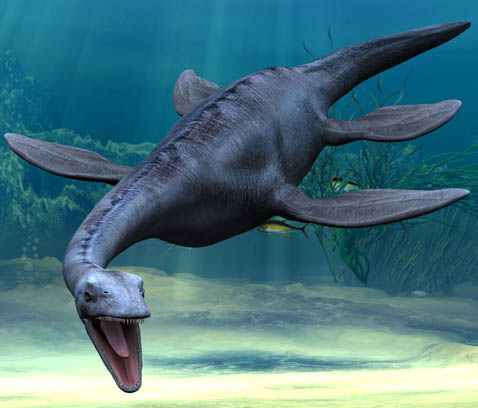Sure, I should probably be posting about knitting or something, or have a Favorite Things Friday post, but I'm just not feeling it, ya know? What I am feeling, or rather, what I am choosing to write about today, is about a plisosaur. A sea monster. That's right. I'm a huge fan of cryptozoology, the Loch Ness Monster, Bigfoot, all that good stuff. I was watching a show on Animal Planet, Lost Tapes, which is about cryptids, and they were discussing a pliosaur in Monterey Bay. They showed a picture of an animal that was found in 1977 by a Japanese fishing vessel, the Zuiyo-maru, off the coast of New Zealand.
You can see the pictures HERE, HERE, HERE and HERE.
Just as a warning, they are quite disgusting, which is why I'm giving out links rather than posting them on here. This guy, whatever he is, has been dead and has had time to decompose for quite a while.
Looks a lot like a plesiosaur, doesn't it? Oh, what's a plesiosar? Nessie, Champ.... these guys:
But is the Zuiyo-maru carcass really a plisosaur? Is this specimen the proof we've been looking for that these things really do exist? Of course, a lot of scientists don't agree with this. They think it could be a basking shark which are known to decompose into "pseudoplisosaur" forms, a small or adolescent whale whose rotten skin was sloughed off, another species of shark, a sea lion or a turtle without it's shell. (A sea lion, really? That'd be a whole different investigation. Super size sea lions. Good lord.) Why so many different theories? The article stated it was "partly due to the fact that many biologists and zoologists are used to working with complete, fresh specimens rather than badly decomposed carcasses (or worse, photos of such), in which both external and internal organs can be quite different from their appearance in living animals (Obata and Tomoda, p 46)" That's entirely true. I also think they're fishing, excuse the pun, for a known species. I'm not saying of course it's an extinct animal, but science is so quick to think it's not possible. Remember the coelacanth?
These guys were thought to have been extinct since the end of the Cretaceous Period, but was discovered alive in 1938 off the coast of South Africa. If he was found, why can't modern science even entertain the possibility that there could be other animals?! Every culture, in almost every part of the Earth, share multiple legends. How did (a) the ancients even come up with this stuff and (b) share such similar sightings and mythologies if they were separated by oceans and vast expanses of land?
I digress. Back to the pliosaur. The article and the scientists who studied the pictures and tissue samples have pretty much decided it was a basking shark at one point.
They're the second largest [known] whale on the planet. In fact, many scientists believe these sharks were the cause for many misidentification of sea monsters in early seafaring days. They swim slowly with their mouth open into swarms of plankton, their dorsal fins visible above the water line. They are even know to line up one right after another, thus resembling the humps on sea monsters.
Above is a chart showing a basking shark hanging out. B is one feeding, and C is how the skin and fat have decomposed. Chromotography tests along with profiling the amino acids have shown the creature is closer to a blue shark. The long thin neck can be accounted for by the decomposition of the gill-arch and loss of jaws. But that can't be the whole story. Though Japanese shark-fin processors immediately identified the creature as a shark, there are some glaring inconsistencies, such as the lack of ammonia smell that usually accompanies dead sharks, the hardened skeletal head rather than cartilaginous and the obvious visual similarities between it and a plisosaur.
Despite all the mismatched facts, there can be no definite identification. The scientists working, over 30 years ago had only tissue samples and photographs to work on, rather than a head or a vertebra which would have lead to more definite results. It seems like no matter what happen, the only way the mass populace and modern science (excepting, those of course, who do believe in the existence of animals unknown to science) that a real flesh and blood animal must be seen in order to convince people.
~
Information, photographs and quotes courtesy Sea-monster or Shark? An Analysis of a Supposed PLesiosaur Caracass Netted in 1977 by Glen J. Kuban.
Images courtesy Google Images.
MonsterQuest airs on History Channel; check local listings
Lost Tapes airs on Animal Planet; check local listings.






2 comments:
A science post! Although some may say it's pseudo-science, I'm happy to see a post that strays from your comfort zone of yarn, art and kitties ;) NOVA has a great video on the Loch Ness Monster and when it's over, I am that much closer to believing ;D And I find myself quoting that commercial where the garage mechanic references the coelacanth.
Love your new pink hippo, too!
I'm a huge science geek, even if it is "pseudo" science. I was going to major in biology but couldn't get past the basic cell class. :( I still know tons about marine biology, dinosaurs, and hippos and cats, of course. Pff, I don't need no stinkin degree!
Thanks, I love her, too! She's my new unofficial mascot!
Post a Comment